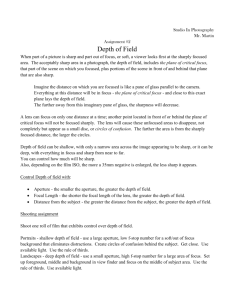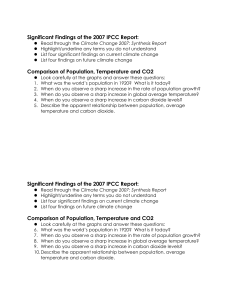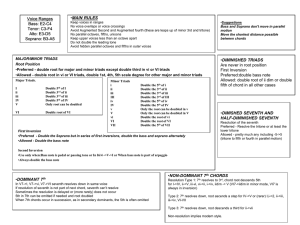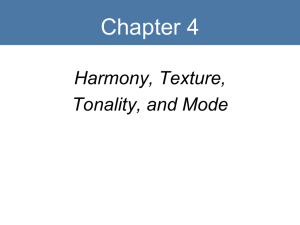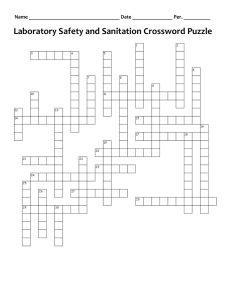Kenny Lovern - david bard
advertisement
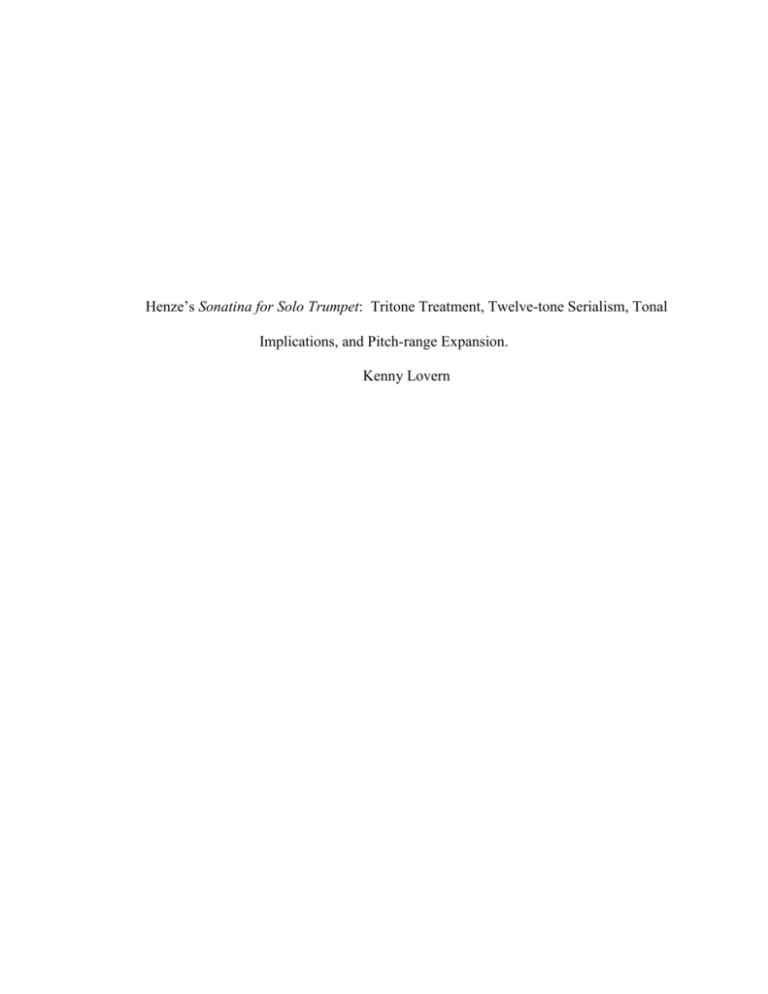
Henze’s Sonatina for Solo Trumpet: Tritone Treatment, Twelve-tone Serialism, Tonal Implications, and Pitch-range Expansion. Kenny Lovern Henze’s Sonatina for Solo Trumpet is a three-movement work that requires multiple analytical tools to understand its musical language. While some methodical implements are only useful for specific movements, there are certain musical aspects that can be observed and heard throughout the entire piece. The traits of Henze’s Sonatina that I will address are tritone interval treatment, twelve-tone serialism, tonal implications, and pitch-range expansion. The manner in which the tritone interval it treated is consistent throughout all three movements of Henze’s Sonatina. Often the tritone is preceded and followed by either a perfect fourth, or a perfect fifth. The effect created is a consonant-dissonant-consonant interval progression and resolution. In many cases a repeated pitch acts as an axis in which the perfect fourth, perfect fifth and tritone are generated. An example of this can be found in the first statement of the first movement as shown in Example 1. Example 1. Tritone treatment in the first statement of the first movement. F natural axis P5 TT B natural axis P4 TT D natural axis P4 P4 TT P5 TT P5 Example one shows B flat moving through D natural to F natural, creating a perfect fifth interval. A tritone interval is then created when F natural moves to B natural, and is sustained through these repeated pitches, in which F natural acts as an axis. B natural then becomes the axis through the middle of the statement where F sharp moves to B natural, creating a perfect fourth. The F sharp then descends a semitone to F natural, generating a tritone against the B natural, then ascends back to F sharp resolving to a perfect fourth. D natural is the axis at the end of the statement. G natural descends to D natural creating a perfect fourth, and then a tritone is produced as D natural descends to G sharp. This tritone interval is sustained towards the end of the phrase as D natural moves through A natural to produce a perfect fifth, then reinstates the tritone toward the end of the statement with the return of G sharp. The dissonant tritone interval is finally resolved at the end of the statement when the phrase ends on A natural generating a consonant perfect fifth. A similar example of this tritone treatment can be found in the second movement as displayed in Example 2. Example 2. Tritone treatment, second movement, second line. F sharp axis TT C sharp axis TT P5 E flat axis P4 TT P5 P4 P5 TT The third movement also displays this same type of interval progression and resolution. Example 3 demonstrates a complex interlocking of perfect fourths, perfect fifths and tritones in which the final tritone resolves to a consonant perfect fifth at the end of the phrase. Example 3. Tritone treatment, third movement, mm. 9-10. m. 9 m. 10 P4 TT P4 P4 TT P5 P4 P4 P4 TT P5 The third movement also uses twelve-tone serialism as a compositional method. It should be noted that this is the only movement that uses this technique, making it the least significant organizing component to the overall structure of the entire work. In addition, Henze does not use the twelve-tone process strictly. There are many examples of pitch-order reversal, and in some cases, a complete reshuffling of the row. Example 4a presents the matrix used in the third movement, and Example 4b demonstrates the initial presentation of the prime row. Example 4a. Twelve-tone matrix, third movement. I11 I10 I5 I9 I4 I6 I3 I8 I1 I7 I2 I0 P11 11 10 5 9 4 6 3 8 1 7 2 0 R11 P0 0 11 6 10 5 7 4 9 2 8 3 1 R0 P5 5 4 11 3 10 0 9 2 7 1 8 6 R5 P1 1 0 7 11 6 8 5 10 3 9 4 2 R1 P6 6 5 0 4 11 1 10 3 8 2 9 7 R6 P4 4 3 10 2 9 11 8 1 6 0 7 5 R4 P7 7 6 1 5 0 2 11 4 9 3 10 8 R7 P2 2 1 8 0 7 9 6 11 4 10 5 3 R2 P9 9 8 3 7 2 4 1 6 11 5 0 10 R9 P3 3 2 9 1 8 10 7 0 5 11 6 4 R3 P8 8 7 2 6 1 3 0 5 10 4 11 9 R8 P10 10 9 4 8 3 5 2 7 0 6 1 11 R10 RI11 RI10 RI5 RI9 RI4 RI6 RI3 RI8 RI1 RI7 RI2 RI0 Example 4b. Initial presentation of the prime row, third movement, m. 1. m. 1, P11 TT Order position: 1 2 3 4 5 6 7 8 9 10 11 12 Tone-row order reversal occurs at multiple points within the third movement. This reversal takes place between order positions nine and ten within the prime and inverted rows, and between order positions three and four within the retrograde, and retrograde inverted rows. Interestingly, these order positions contain the only instance that a tritone occurs between consecutive pitches found in the row as shown in the previous example. Reversal does not affect the interval at that particular point, but does change the intervals going into the tritone, and those following the tritone. When the order positions are unaltered, the unordered pitch-class intervals that precede and follow the tritone are i (5) as shown in Example 5a. When the order positions are reversed, the unordered pitch-class intervals that precede and follow the tritone are i (1) as shown in Example 5b. Example 5a. Intervals that precede and follow the tritone found in the unaltered prime row, third movement, m. 1. P4, i (5) P4, i (5) m. 1, P11 TT Order position: 1 2 3 4 5 6 7 8 9 10 11 12 Example 5b. Intervals that precede and follow the tritone found in P0 with order positions 9 and 10 reversed, third movement, mm. 10-11. M7, i (1) TT Aug. 8va, i (1) m. 10 m. 11 P0 . Order position: 1 2 3 4 5 6 7 8 10 9 11 12 The unaltered order positions of the row results in the previous treatment of the tritone where it is approached and followed by a perfect fourth, or perfect fifth (i (5)). Reversing the order positions presents an opportunity to use larger, disjunct intervals such as a major seventh, or minor ninth interval (i (1)), before and after the tritone. These broad detached intervals are found all throughout the third movement, and are one of the characteristics that differentiate the third movement from the previous two. Implied tonality, albeit subtle, is present in Henze’s Sonatina. This tonal quality is present in the first two movements, but almost completely absent in the third movement. This is due, in part, to the disjunct intervals found within the third movement which make it difficult to hear and locate a tonal center. The twelve-tone row used in the third movement is also constructed is such a way that does not imply a specific tonality. The first movement of Henze’s Sonatina implies a B flat tonality. Major and minor modes of B flat are implied, as well as other modes such as B flat Mixolydian and B flat Phrygian. This is due to the chromatic nature of the first movement. The alteration of D natural, C sharp and D flat within statements found in the first movement obscure the major or minor quality of the mode. Even though the specific mode is unidentifiable, certain sections of the first movement establish B flat as the tonal center. Henze achieves this through different methods. One way that B flat is established can be seen in the beginning of certain statements where a B flat major-major seventh chord is the first arpeggiated harmony. Two examples of this are found in the opening phrase, as well as an abbreviated restatement found in the third line as shown in Example 6a and 6b. Example 6a. B flat major-major seventh in opening statement, first movement, first line. B flat MM7th Example 6b. B flat major-major seventh found in restatement of opening, first movement, third line. B flat MM7th Another way that B flat is established is through the linear movements of the lowest voice of each arpeggio found in the same sections as previously mentioned, as well as the second line of the first movement. These pitches often occur on metrically accented notes, which make them more audible by separating them from the other pitches within the arpeggios. The result created is a compound line where the lowest voice and higher voice each have their own separate identity. Example 7 demonstrates this technique used in the opening statement. Example 7. B flat established by lowest voice of arpeggio, first movement, first line. Scale degrees: 1 2 b7 #2 (b3) 1 2 #2 (b3) 5 Example 7 demonstrates the motion of the lowest note of each arpeggio which starts on B flat and moves through C natural to A natural and then to C sharp. The B flat returns in the middle of the statement and moves though C natural to C sharp and then to F natural. These accented pitches give a sense of scale degrees 1, 2, 3, 5 and 7 in B flat natural minor. Dominant to tonic resolution is also used in the first movement to establish B flat as a tonal center. An example of this can be found in the end of the fourth line, and the beginning of the fifth line towards the end of the first movement. A F major triad and a F augmented triad are arpeggiated at the end of the fourth line. The F augmented triad starts with a metrically accented F natural which is also the lowest voice of the arpeggio. The F natural ascends through A natural, C sharp, E natural, G sharp and ends on an accented C natural. The C natural (supertonic) then resolves to a staccato B flat (tonic) as shown in Example 8. Example 8. Dominant to tonic resolution, first movement, end of the fourth line, beginning of fifth line. Supertonic Bb: Tonic V I The second movement has tonal suggestions as well, although the tonal center in the second movement is E flat instead of B flat. This denotes a larger scale dominant to tonic relationship, where the B flat tonality from the first movement moves to the E flat tonality in the second movement. Whereas the mode of the first movement was difficult to identify, the mode of the second movement is much more audible and consistent. E flat minor is the most prevalent mode used, and is established from the onset of the second movement with the presentation of a arpeggiated E flat minor triad as shown in Example 9. Example 9. Arpeggiated E flat minor triad, beginning of the second movement. E flat minor triad A similar dominant to tonic resolution found towards the end of the first movement can be seen and heard at the end of the second movement. Example 10 shows an A sharp (enharmonic B flat) played triple fortissimo and accented four times by the trumpet player by partially removing the mute from the horn bell. The A sharp (B flat) then moves to two staccato accented D naturals. The D natural then resolves dramatically with a flutter tongue technique quadruple forte to D sharp (E flat) as seen in Example 10. One can hear this as a dominant to leading tone to tonic resolution, where the leading tone is displaced in a higher register. Example 10. Dominant tonic resolution, end of the second movement. Eb: Dominant Leading tone Eb: A# (Bb) V Tonic D natural D# (Eb) I Although the tonal implications are not as strong in the third movement compared to the first two, a similar dominant to tonic relationship can be found final line of the third movement. This resolution once again involves the leading tone and dominant resolving to tonic in E flat as shown in Example 11. This implies a prolongation of the E flat tonality through the end of the piece. Example 11. Dominant to tonic resolution, end of the third movement. Eb: Leading tone Eb: D natural Dominant V A# (Bb) Tonic D# (Eb) I One trait that is common throughout all of Henze’s Sonatina is pitch-range expansion. This expansion is present not only in the foreground and middle ground, but also extends through the entire background structure of the work. An example of pitch-range expansion at the foreground level can be found in the opening statement of the first movement. The first movement begins with an arpeggio that has a range of thirteen semitones which starts on pitch B flat. The next two arpeggios contract in size until an arpeggio which begins on C sharp expands to fifteen semitones. Further expansion is found with an arpeggio that begins on C sharp extends to twenty semitones, and the final arpeggio which begins on D natural expands to twenty one semitones as shown in Example 12. Example 12. Pitch-range expansion on the foreground level, beginning of first movement. Expansion…………….Expansion……………………Expansion Semitone Range: 13 11 8 15 13 11 20 21 Pitch-range expansion also occurs in the middle ground of the piece and involves the larger musical statements found in each movement. A reoccurring expansion and contraction (much like the previous example) can be seen in each of the three movements on a larger scale. Phrases of larger intervallic range are followed by phrases of smaller scope until the next expansion occurs. Each expansion is larger than the previous one. The statement of the broadest intervallic range occurs towards the end of each movement, and in each case is followed by a contraction. Example 12 demonstrates the pitch-range expansion and contraction found in the larger musical statements of each movement. Example 12. Pitch-range expansion of larger musical statements found in movements one, two and three. First movement: Line number: 1 Semitone range: 2 26 3 21 4 16 5 29 16 Second Movement: Line number: 1 2 Semitone range: 17 8 3 18 4 5 20 18 6 16 7 10 8 10 19 9 23 Third Movement: Measure number: Semitone range: Line number: 1 2 2 3 -------- 9---13 14 15 1 21 22 28 22 27 3 25 4 33 5 29 27 10 11 Pitch-range expansion also takes place within the background structure of the work. This is discovered when comparing the overall pitch range of each movement. The first and second movements interestingly both have the identical range of twenty nine semitones. The difference between the range of the first movement and that of the second movement is that the second movement’s rage is a whole step higher in pitch. The expansion that occurs in the third movement extends its range to thirty three semitones as diagramed in Example 13. Example 13. Pitch-range expansion between movements. 1st mov. Semitone Range: 29 2nd mov. 29 3rd mov. 33 Henze’s Sonatina for Solo Trumpet is a complex piece which uses many different colors from the pallet to complete the overall work. Elements such as twelve-tone serialism and tonal implications only cover part of the canvas. I believe that the treatment of the tritone and pitchrange expansion are the colors that tie the overall composition together. I believe that my analysis of this piece only scratched the surface of what is actually occurring in this music. While listening to the piece, there is a strong sense of cohesion that is prevalent within each movement, and the work as a whole. In studying the score, it is difficult to uncover the one unifying element that ties everything together. That’s what makes this piece fascinating. I left with more questions after analysis then before I even looked at the work. What governs Henze’s choice of enharmonic spelling; why D sharp and not E flat? What is the significance of the extended techniques, and why do they occur on certain pitches? Is there a specific pattern to how the rhythms are grouped in the first movement? All of these questions of course would require additional study.

